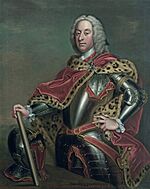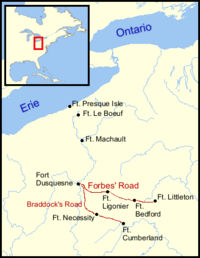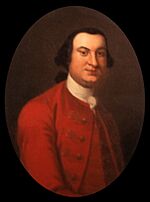John Forbes (British Army officer) facts for kids
Quick facts for kids
John Forbes
|
|
|---|---|
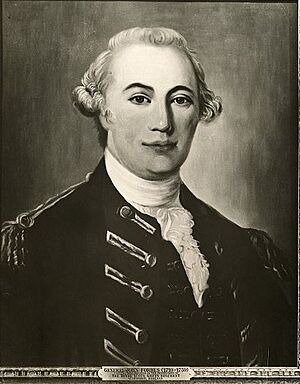
Brigadier General John Forbes 1707-1759
|
|
| Born | 5 September 1707 Dunfermline, Scotland |
| Died | 11 March 1759 (aged 51) Philadelphia, British America |
| Buried | |
| Allegiance | |
| Service/ |
|
| Years of service | 1735–1759 |
| Rank | Brigadier-general |
| Unit | 17th Foot 1757-1759 |
| Battles/wars | War of the Austrian Succession Dettingen (1743) Fontenoy (1745) Lauffeld (1747) French and Indian War Louisbourg Expedition (1757) Fort Duquesne (1758) |
| Relations | Duncan Forbes, Lord President |
John Forbes (born September 5, 1707 – died March 11, 1759) was a Scottish soldier. He served in the British Army from 1729 until his death.
During the French and Indian War (1754-1763), he led an important mission. In 1758, he commanded the Forbes Expedition. This expedition captured the French outpost of Fort Duquesne. Today, this place is Pittsburgh, Pennsylvania. To do this, his troops built a military path. This path was called the Forbes Road. It later became a key route for people settling in the Western United States.
Forbes died in Philadelphia. He was buried at Christ Church.
Contents
Early Life and Family
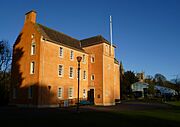
John Forbes was born in Dunfermline, Scotland. His birthday was September 5, 1707. He was the youngest child of Colonel John Forbes. His father died before John was born. His mother was Elizabeth Graham.
In 1701, his father bought Pittencrieff Park. John grew up in this home near Dunfermline. He had five older sisters. He also had two older brothers, Arthur and Hugh. Arthur inherited the family estate. Hugh became a lawyer.
All three Forbes brothers faced money problems. John borrowed a lot to pay for his army career. Arthur spent too much expanding Pittencrieff. The estate had to be sold after Arthur's death.
Military Career
The Forbes family was important in Inverness. They supported King George I. They were also friends with the Campbell Dukes of Argyll. John's cousin, Duncan Forbes, became a top Scottish legal officer in 1737. He helped stop the 1745 Jacobite Rising. These family connections were very helpful for John's career.
John Forbes studied in Dunfermline. He might have studied medicine at Edinburgh University. In September 1729, he became a surgeon in the Royal Scots Greys. This was an army regiment based in Scotland. He stayed with this regiment for 28 years. In 1735, he became a cornet, a junior officer rank.
Promotions were slow in the army during peacetime (1713-1739). Also, officers often had to buy their ranks. This made it hard for people like Forbes who didn't have much money. In April 1742, he became a lieutenant. Soon after, his regiment went to the Austrian Netherlands. They fought in the War of the Austrian Succession.
Forbes became an aide-de-camp (a personal assistant) to James Campbell of Lawers. Campbell was the colonel of the Scots Greys. He also commanded the Allied cavalry. Forbes fought at the Battle of Dettingen in June 1743. In September 1744, he bought a commission to become a captain.
Battles and Challenges
At the Battle of Fontenoy in May 1745, Forbes delivered orders. He was told to tell Brigadier General Ingoldsby to attack a French fort. During the battle, Sir James Campbell was badly hurt. Forbes stayed with him after the Allied forces retreated. Forbes was then taken prisoner. He was soon released. Campbell died a few days later. Forbes was very sad about his death.
After Fontenoy, Ingoldsby faced a court-martial. This is a military trial. He was accused of not following orders to attack the French position. Ingoldsby tried to blame Forbes. But Forbes testified at the trial. Ingoldsby was forced to resign from the army.
Forbes did not get special help from the Allied commander, Cumberland. However, he became an aide to the Earl of Stair. Stair took over from Campbell as colonel of the Scots Greys. Some army units went to Britain in October 1745. They went to stop the Jacobite Rising. But the cavalry did not go. It was hard to move horses by sea in winter. Forbes was not at the Battle of Culloden. He returned to Flanders in December 1745. He became a Deputy Quartermaster-General. When the war ended in 1748, he was a major.
Forbes spent the next few years on duty in Britain. In November 1750, he bought a commission. He became a Lieutenant-Colonel of the Scots Greys. He borrowed £5,000 to do this. But with few chances for more promotions, his debts grew.
The Forbes Expedition to Fort Duquesne
The Treaty of Aix-la-Chapelle tried to solve land arguments. These were between British and French colonies in North America. But neither side gave in. This led to the French and Indian War (1754-1763). In 1755, General Braddock led an expedition. It tried to capture Fort Duquesne. But it ended in a terrible defeat.
In 1756, the Seven Years' War began. This was a global conflict. Forbes was promoted to colonel of the 17th Foot in March 1757. His unit was sent to Nova Scotia. They were part of a force trying to capture Louisbourg.
After the 1757 Louisbourg Expedition failed, Forbes got a new command. In December 1757, he was promoted to Brigadier general. He was given command of another attack on Fort Duquesne. His force included 1,400 regular soldiers. It also had 400 soldiers from the Royal American Regiment. These were led by Lt-Colonel Henry Bouquet. There were also 1,000 Scottish soldiers. Plus, 5,000 local militia from Virginia and Pennsylvania joined. These were led by George Washington. Washington had been to Fort Le Boeuf in 1753. He also went with Braddock in 1755.
Forbes decided to build a new road. This road would start from the Pennsylvania frontier. It would have fewer river crossings than Braddock's old road. Braddock's road followed a path cut by the Virginia-based Ohio Company. This decision caused protests from Virginian officers. Many of them had invested in the Ohio Company. This included two of Washington's brothers.
As a compromise, Forbes agreed to improve Braddock's old road. But he would still use the new route through Pennsylvania. A main base was set up at Carlisle, Pennsylvania. A path was cut through the Allegheny Mountains. This path became the famous Forbes Road. Forbes was already very sick. He had to be carried in a special chair. He relied a lot on Bouquet, who led the advance troops. Lt-Colonel John St Clair oversaw the road building. But he was not very good at it. So, Forbes had to do much of the work himself, despite his poor health.
Forbes also worked to build good relationships with local Native Americans. They had not cooperated with the British before. The British also captured Fort Frontenac in August. This made the British look stronger. It also hurt the local economy because French traders were gone. This careful plan was put at risk on September 15, 1758. A group of soldiers under Major James Grant went too far ahead. They suffered over 300 casualties in the Battle of Fort Duquesne. Forbes decided to stop operations for a while. But on October 26, 13 Ohio Valley tribes signed the Treaty of Easton. They signed it with Pennsylvania and New Jersey.
After losing their Native American allies, the French left Fort Duquesne. The British took control on November 25. Forbes ordered a new fort to be built. It was named Fort Pitt, after British Secretary of State Pitt the Elder. He also started a settlement between the rivers. This is where modern Pittsburgh is today. Forbes' health got much worse during the campaign. He had a "wasting disease." It is thought to have been stomach cancer and severe dysentery.
On December 3, 1758, he left Colonel Hugh Mercer in charge. Forbes returned to Philadelphia. He died there on March 11, 1759. He was buried with full military honors. In his last letters, he advised Lord Amherst. Amherst was the new commander in North America. Forbes told him to make good relationships with Native Americans a priority. He said, "not to think lightly of them or their friendship."
Legacy
Forbes Field was a famous baseball stadium. It was the home of the Pittsburgh Pirates baseball team. It was also home to the Pittsburgh Steelers football team. And the Pitt Panthers football team. It was named after John Forbes. Forbes Field was America's first stadium made completely of steel and concrete.
Forbes Avenue is a main street in Pittsburgh. It runs from the Monongahela river in Downtown Pittsburgh to Frick Park. It is named in his honor. The road roughly follows his old colonial path. John Forbes Lane in Kanpur, India, is also named after him.


